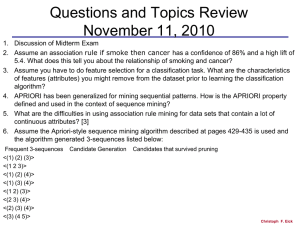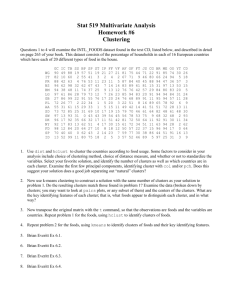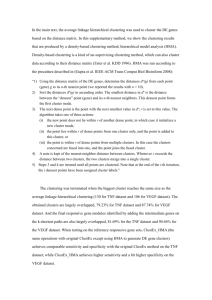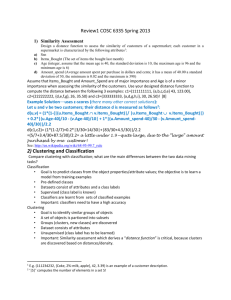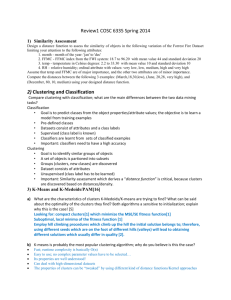Cluster analysis or clustering is a common technique for
advertisement
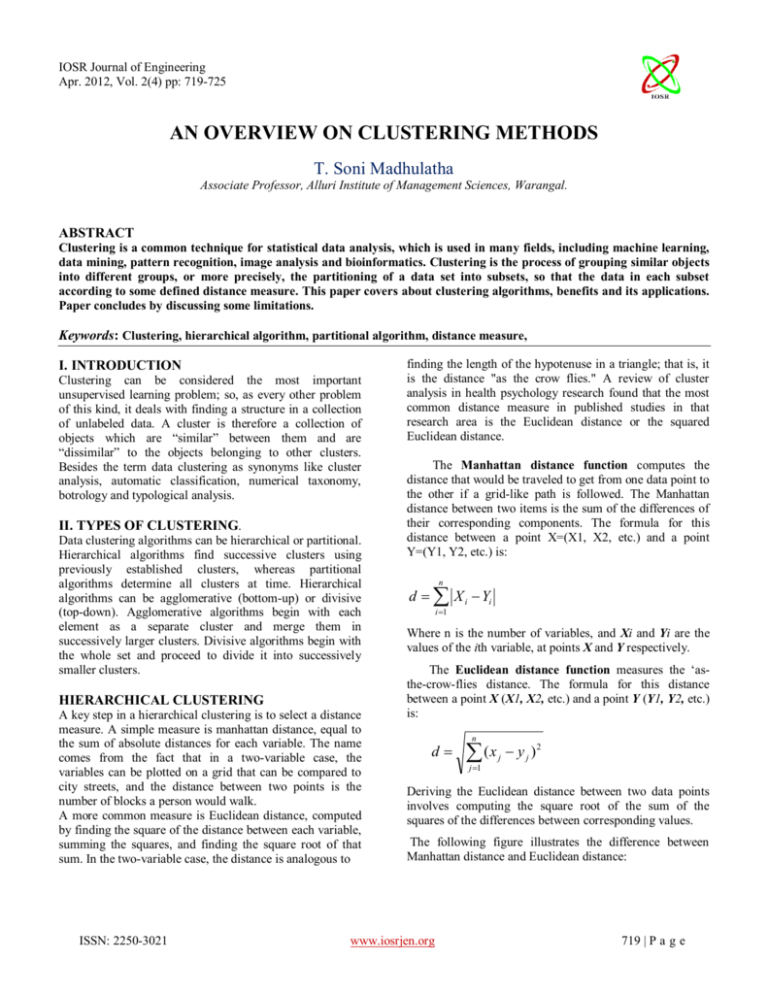
IOSR Journal of Engineering
Apr. 2012, Vol. 2(4) pp: 719-725
AN OVERVIEW ON CLUSTERING METHODS
T. Soni Madhulatha
Associate Professor, Alluri Institute of Management Sciences, Warangal.
ABSTRACT
Clustering is a common technique for statistical data analysis, which is used in many fields, including machine learning,
data mining, pattern recognition, image analysis and bioinformatics. Clustering is the process of grouping similar objects
into different groups, or more precisely, the partitioning of a data set into subsets, so that the data in each subset
according to some defined distance measure. This paper covers about clustering algorithms, benefits and its applications.
Paper concludes by discussing some limitations.
Keywords: Clustering, hierarchical algorithm, partitional algorithm, distance measure,
I. INTRODUCTION
Clustering can be considered the most important
unsupervised learning problem; so, as every other problem
of this kind, it deals with finding a structure in a collection
of unlabeled data. A cluster is therefore a collection of
objects which are “similar” between them and are
“dissimilar” to the objects belonging to other clusters.
Besides the term data clustering as synonyms like cluster
analysis, automatic classification, numerical taxonomy,
botrology and typological analysis.
II. TYPES OF CLUSTERING.
Data clustering algorithms can be hierarchical or partitional.
Hierarchical algorithms find successive clusters using
previously established clusters, whereas partitional
algorithms determine all clusters at time. Hierarchical
algorithms can be agglomerative (bottom-up) or divisive
(top-down). Agglomerative algorithms begin with each
element as a separate cluster and merge them in
successively larger clusters. Divisive algorithms begin with
the whole set and proceed to divide it into successively
smaller clusters.
HIERARCHICAL CLUSTERING
A key step in a hierarchical clustering is to select a distance
measure. A simple measure is manhattan distance, equal to
the sum of absolute distances for each variable. The name
comes from the fact that in a two-variable case, the
variables can be plotted on a grid that can be compared to
city streets, and the distance between two points is the
number of blocks a person would walk.
A more common measure is Euclidean distance, computed
by finding the square of the distance between each variable,
summing the squares, and finding the square root of that
sum. In the two-variable case, the distance is analogous to
ISSN: 2250-3021
finding the length of the hypotenuse in a triangle; that is, it
is the distance "as the crow flies." A review of cluster
analysis in health psychology research found that the most
common distance measure in published studies in that
research area is the Euclidean distance or the squared
Euclidean distance.
The Manhattan distance function computes the
distance that would be traveled to get from one data point to
the other if a grid-like path is followed. The Manhattan
distance between two items is the sum of the differences of
their corresponding components. The formula for this
distance between a point X=(X1, X2, etc.) and a point
Y=(Y1, Y2, etc.) is:
n
d X i Yi
i 1
Where n is the number of variables, and Xi and Yi are the
values of the ith variable, at points X and Y respectively.
The Euclidean distance function measures the „asthe-crow-flies distance. The formula for this distance
between a point X (X1, X2, etc.) and a point Y (Y1, Y2, etc.)
is:
d
n
(x
j 1
j
y j )2
Deriving the Euclidean distance between two data points
involves computing the square root of the sum of the
squares of the differences between corresponding values.
The following figure illustrates the difference between
Manhattan distance and Euclidean distance:
www.iosrjen.org
719 | P a g e
IOSR Journal of Engineering
Apr. 2012, Vol. 2(4) pp: 719-725
1
card ( A)card ( B )
Manhattan distance
d ( x, y)
x A yB
The sum of all intra-cluster variance
The increase in variance for the cluster being merged
The probability that candidate clusters spawn from the
same distribution function.
Euclidean distance
This method builds the hierarchy from the individual
elements by progressively merging clusters. Again, we have
six elements {a} {b} {c} {d} {e} and {f}. The first step is
to determine which elements to merge in a cluster. Usually,
we want to take the two closest elements, therefore we must
define a distance between elements. One can also construct
a distance matrix at this stage.
Each agglomeration occurs at a greater distance between
clusters than the previous agglomeration, and one can
decide to stop clustering either when the clusters are too far
apart to be merged or when there is a sufficiently small
number of clusters.
Agglomerative hierarchical clustering
For example, suppose these data are to be analyzed, where
pixel euclidean distance is the distance metric.
Usually the distance between two clusters and is one of the
following:
The maximum distance between elements of each cluster
is also called complete linkage clustering.
max d(x, y) : x A, y B
The minimum distance between elements of each cluster
is also called single linkage clustering.
min d(x, y) : x A, y B
The mean distance between elements of each cluster is
also called average linkage clustering.
ISSN: 2250-3021
Divisive clustering
So far we have only looked at agglomerative clustering, but
a cluster hierarchy can also be generated top-down. This
variant of hierarchical clustering is called top-down
clustering or divisive clustering. We start at the top with all
documents in one cluster. The cluster is split using a flat
clustering algorithm. This procedure is applied recursively
until each document is in its own singleton cluster.
Top-down clustering is conceptually more complex than
bottom-up clustering since we need a second, flat clustering
algorithm as a ``subroutine''. It has the advantage of being
more efficient if we do not generate a complete hierarchy
all the way down to individual document leaves. For a fixed
number of top levels, using an efficient flat algorithm like
K-means, top-down algorithms are linear in the number of
documents and clusters
www.iosrjen.org
720 | P a g e
IOSR Journal of Engineering
Apr. 2012, Vol. 2(4) pp: 719-725
Hierarchal method suffers from the fact that once the
merge/split is done, it can never be undone. This rigidity is
useful in that is useful in that it leads to smaller
computation costs by not worrying about a combinatorial
number of different choices.
However there are two approaches to improve the quality of
hierarchical clustering
Perform careful analysis of object linkages at each
hierarchical partitioning such as CURE and Chameleon.
Integrate hierarchical agglomeration and then redefine the
result using iterative relocation as in BRICH
PARTITIONAL CLUSTERING:
Partitioning algorithms are based on specifying an initial
number of groups, and iteratively reallocating objects
among groups to convergence. This algorithm typically
determines all clusters at once. Most applications adopt one
of two popular heuristic methods like
k-mean algorithm
k-medoids algorithm
K-means algorithm
The K-means algorithm assigns each point to the cluster
whose center also called centroid is nearest. The center is
the average of all the points in the cluster that is, its
coordinates are the arithmetic mean for each dimension
separately over all the points in the cluster.
The pseudo code of the k-means algorithm is to explain
how it works:
A. Choose K as the number of clusters.
B. Initialize the codebook vectors of the K clusters
(randomly, for instance)
C. For every new sample vector:
a. Compute the distance between the new vector and
every cluster's codebook vector.
b. Re-compute the closest codebook vector with the
new vector, using a learning rate that decreases in time.
The reason behind choosing the k-means algorithm to study
is its popularity for the following reasons:
• Its time complexity is O (nkl), where n is the number
of patterns, k is the number of clusters, and l is the
number of iterations taken by the algorithm to
converge.
•
Its space complexity is O (k+n). It requires
additional space to store the data matrix.
•
It is order-independent; for a given initial seed set of
cluster centers, it generates the same partition of the data
irrespective of the order in which the patterns are presented
to the algorithm.
K-medoids algorithm:
The basic strategy of k-medoids algorithm is each cluster is
ISSN: 2250-3021
represented by one of the objects located near the center of
the cluster. PAM (Partitioning around Medoids) was one of
the first k-medoids algorithm is introduced.
The pseudo code of the k-medoids algorithm is to explain
how it works:
Arbitrarily choose k objects as the initial medoids Repeat
Assign each remaining object to the cluster with the nearest
medoids Randomly select a non-medoid object Orandom
Compute the total cost, S, of swapping Oj with Orandom
If S<0 the swap Oj with Orandom to form the new set of
k-medoids
Until no changes
K-medoids method is more robust than k-mean in presence
of noise and outliers because a medoids is less influenced
by outliers or other extreme values than a mean.
DENSITY-BASED CLUSTERING
Density-based clustering algorithms are devised to discover
arbitrary-shaped clusters. In this approach, a cluster is
regarded as a region in which the density of data objects
exceeds a threshold. DBSCAN and SSN are two typical
algorithms of this kind.
DBSCAN algorithm
The DBSCAN algorithm was first introduced by Ester, and
relies on a density-based notion of clusters. Clusters are
identified by looking at the density of points. Regions with
a high density of points depict the existence of clusters
whereas regions with a low density of points indicate
clusters of noise or clusters of outliers. This algorithm is
particularly suited to deal with large datasets, with noise,
and is able to identify clusters with different sizes and
shapes.
The key idea of the DBSCAN algorithm is that, for each
point of a cluster, the neighbourhood of a given radius has
to contain at least a minimum number of points, that is, the
density in the neighbourhood has to exceed some
predefined threshold.
This algorithm needs three input parameters:
- k, the neighbour list size;
- Eps, the radius that delimitate the neighbourhood area of a
point (Eps neighbourhood);
- MinPts, the minimum number of points that must exist in
the Eps-neighbourhood.
www.iosrjen.org
721 | P a g e
IOSR Journal of Engineering
Apr. 2012, Vol. 2(4) pp: 719-725
The clustering process is based on the classification of the
points in the dataset as core points, border points and noise
points, and on the use of density relations between points to
form the clusters.
The pseudo code of the DBSCAN algorithm is to explain
how it works:
To clusters a dataset, our DBSCAN implementation starts
by identifying the k nearest neighbours of each point and
identify the farthest k nearest neighbour. The average of all
this distance is then calculated.
For each point of the dataset the algorithm identifies the
directly density-reachable points using the Eps threshold
provided by the user and classifies the points into core or
border points.
It then loop trough all points of the dataset and for the core
points it starts to construct a new cluster with the support of
the GetDRPoints() procedure that follows the definition of
density reachable points.
In this phase the value used as Eps threshold is the
average distance calculated previously. At the end, the
composition of the clusters is verified in order to check if
there exist clusters that can be merged together. This can
append if two points of different clusters are at a distance
less than Eps.
Note: DBSCAN does not deal very well with clusters of
different densities.
SNN ALGORITHM
The SNN algorithm, as DBSCAN, is a density-based
clustering algorithm. The main difference between this
algorithm and DBSCAN is that it defines the similarity
between points by looking at the number of nearest
neighbours that two points share. Using this similarity
measure in the SNN algorithm, the density is defined as the
sum of the similarities of the nearest neighbours of a point.
Points with high density become core points, while points
with low density represent noise points. All remainder
points that are strongly similar to a specific core points will
represent a new clusters.
The SNN algorithm needs three inputs parameters:
- K, the neighbours‟ list size;
Then the similarity between pairs of points is calculated in
terms of how many nearest neighbours the two points share.
Using this similarity measure, the density of each point can
be calculated as being the numbers of neighbours with
which the number of shared neighbours is equal or greater
than Eps.
The points are classified as being core points, if the density
of the point is equal or greater than MinPts. At this point,
the algorithm has all the information needed to start to build
the clusters. Those start to be constructed around the core
points.
However, these clusters do not contain all points. They
contain only points that come from regions of relatively
uniform density. The points that are not classified into any
cluster are classified as noise points.
GRID-BASED CLUSTERING
The grid based clustering approach uses a multiresolution
grid data structure. It quantizes the space into a finite
number of cells that form a grid structure on which all the
operations for clustering are performed. Grid approach
includes STING (STatistical INformation Grid) approach
and CLIQUE
Basic Grid-based Algorithm
1. Define a set of grid-cells
2. Assign objects to the appropriate grid cell and compute
the density of each cell.
3. Eliminate cells, whose density is below a certain
threshold t.
4. Form clusters from contiguous (adjacent) groups of dense
cells.
The pseudo code of the STING algorithm is to explain how
it works:
The spatial area is divided into rectangular cells
There are several levels of cells corresponding to different
levels of resolution
Each cell is partitioned into a number of smaller cells in the
next level. Statistical info of each cell is calculated and
stored beforehand and is used to answer queries
Parameters of higher level cells can be easily calculated
from parameters of lower level cell count, mean, s, min,
max type of distribution—normal, uniform, etc.
Use a top-down approach to answer spatial data queries
- Eps, the threshold density;
- MinPts, the threshold that define the core points.
The pseudo code of the SSN algorithm is to explain how
it works:
Start from a pre-selected layer—typically with a small
number of cells from the pre-selected layer until you reach
the bottom layer do the following:
Define the input parameters.
For each cell in the current level compute the confidence
interval indicating a cell‟s relevance to a given query;
1. If it is relevant, include the cell in a cluster
Find the K nearest neighbours of each point of the dataset.
ISSN: 2250-3021
www.iosrjen.org
722 | P a g e
IOSR Journal of Engineering
Apr. 2012, Vol. 2(4) pp: 719-725
2.
If it irrelevant, remove cell from further consideration
3. otherwise, look for relevant cells at the next lower layer
1. Combine relevant cells into relevant regions (based on
grid-neighborhood) and return the so obtained clusters
as your answers.
Advantages:
Query-independent,
easy
to
parallelize,
incremental update O(K), where K is the number of grid
cells at the lowest level
Disadvantages:
All the cluster boundaries are either horizontal or
vertical, and no diagonal boundary is detected
MODEL-BASED CLUSTERING
Model-Based Clustering methods attempt to optimize the fit
between the given data and some mathematical model.
Such methods often based on the assumption that the data
are generated by mixture of underlying probability
distributions. Model-Based Clustering methods follow two
major approaches: Statistical Approach or Neural network
approach
1. Clustering is also performed by having several units
competing for the current object
2. The unit whose weight vector is closest to the current
object wins
3. The winner and its neighbors learn by having their
weights adjusted
4. SOMs are believed to resemble processing that can occur
in the brain
5. Useful for visualizing high-dimensional data in 2- or 3-D
space
In model-based clustering, the data x are viewed as coming
P from a mixture density
1
exp ( xi k )T 1 ( xi k )
2
k
( xi ; k , k )
det(2 k )
For univariate data, the covariance matrix reduces to a
scalar variance. The likelihood for data consisting of n
observations assuming a Gaussian mixture model with G
multivariate mixture components is
n
G
T ( x ; ,
i 1 k 1
k
i
k
k
).
MCLUST is probably the most well known model-based
This is all about various clustering algorithms.
III. HOW TO DETERMINE THE NUMBER OF
CLUSTERS
Many clustering algorithms require the specification of the
number of clusters to produce in the input data set, prior to
execution of the algorithm. Barring knowledge of the
proper value beforehand, the appropriate value must be
determined, a problem on its own for which a number of
techniques have been developed.
–
–
–
–
If the number of clusters known, termination condition
is given!
In general, set a distance threshold value (termination
condition)
The K-cluster lifetime as the range of threshold values
on the dendrogram tree that leads to the identification
of K clusters
Heuristic rule: cut a dendrogram tree with maximum
life time
One simple rule of thumb sets the number to
G
f ( x) Tk f k ( x)
k n
k 1
where fk is the probability density function of the
observations in group k, and Tk is the probability that an
observation comes from the kth mixture component
Each component is usually modeled by the normal or
Gaussian distribution. Component distributions are
characterized by the mean μk and the covariance matrix ∑k,
and have the probability density function
ISSN: 2250-3021
2 with n as the number of objects .
Elbow criterion
The elbow criterion is a common rule of thumb to
determine what number of clusters should be chosen, for
example for k-means and agglomerative hierarchical
clustering. The elbow criterion says that you should choose
a number of clusters so that adding another cluster doesn't
add sufficient information. More precisely, if you graph the
percentage of variance explained by the clusters against the
number of clusters, the first clusters will add much
information, but at some point the marginal gain will drop,
giving an angle in the graph.
www.iosrjen.org
723 | P a g e
IOSR Journal of Engineering
Apr. 2012, Vol. 2(4) pp: 719-725
Another set of methods for determining the number of
clusters are information criteria, such as :
The Akaike information criterion (AIC), The Bayesian
information criterion (BIC), The Deviance information
criterion (DIC).
bas
ed
Alg
orit
hm
IV. HOW ALGORITHMS ARE COMPARED
The above clustering algorithms are compared according to
the following factors:
The size of the dataset,
Number of the clusters,
Type of dataset,
Type of software
Table 1 explains how the four algorithms
compared and the conclusions are written down.
Size of
Dataset
Number
of
Clusters
Type
of
Dataset
Type of
Software
Parti
tiona
l
Alg
orit
hm
Huge
Dataset
&
Small
Dataset
Ideal
Dataset
&
Random
Dataset
LNKnet
Package
&
Cluster and
TreeView
Package
Hie
rarc
hica
l
Alg
orit
hm
Huge
Dataset
&
Small
Dataset
Ideal
Dataset
&
Random
Dataset
LNKnet
Package
&
Cluster and
TreeView
Package
Grid
base
d
Alg
orit
hm
Huge
Dataset
&
Small
Dataset
Ideal
Dataset
&
Random
Dataset
LNKnet
Package
&
Cluster and
TreeView
Package
Mo
del-
Huge
Dataset
Large
number
of
cluster
s
&
Small
number
of
clusters
Large
number
of
cluster
s
&
Small
number
of
Clusters
Large
number
of
cluster
s
&
Small
number
of
clusters
Large
number
ISSN: 2250-3021
are
&
Small
Dataset
of
cluster
s
&
Small
number
of
clusters
&
Random
Dataset
&
Cluster and
TreeView
Package
V. POSSIBLE APPLICATIONS
Clustering algorithms can be applied in many fields, for
instance:
Marketing: finding groups of customers with similar
behavior given a large database of customer data
containing their properties and past buying records;
Financial task: Forecasting stock market, currency
exchange rate, bank bankruptcies, un-derstanding and
managing financial risk, trading futures, credit rating,
Biology: classification of plants and animals given their
features;
Libraries: book ordering;
Insurance: identifying groups of motor insurance policy
holders with a high average claim cost; identifying
frauds;
City-planning: identifying groups of houses according to
their house type, value and geographical location;
Earthquake studies: clustering observed earthquake
epicenters to identify dangerous zones;
WWW: document classification; clustering web log data
to discover groups of similar access patterns
VI. CONCLUSION
Ideal
Dataset
LNKnet
Package
Clustering is a descriptive technique. The solution is not
unique and it strongly depends upon the analyst‟s choices.
We described how it is possible to combine different results
in order to obtain stable clusters, not depending too much
on the criteria selected to analyze data. Clustering always
provides groups, even if there is no group structure.
When applying a cluster analysis we are hypothesizing
that the groups exist. But this assumption may be false or
weak. Clustering results‟ should not be generalized. Cases
in the same cluster are similar only with respect to the
information cluster analysis was based on i.e.,
dimensions/variables inducing the dissimilarities.
REFERENCES
1. Han, J. and Kamber, M. Data Mining: Concepts and
Techniques, 2001 (Academic Press, San Diego,
California, USA).
2. Comparision between clustering algorithms- Osama
Abu Abbas.
3. Pham, D.T. and Afify, A.A. Clustering techniques and
their applications in engineering. Submitted to
Proceedings of the Institution of Mechanical Engineers,
www.iosrjen.org
724 | P a g e
IOSR Journal of Engineering
Apr. 2012, Vol. 2(4) pp: 719-725
4.
5.
6.
7.
8.
9.
10.
Part C: Journal of Mechanical Engineering Science,
2006.
Jain, A.K. and Dubes, R.C. Algorithms for Clustering
Data, 1988 (Prentice Hall, Englewood Cliffs, New
Jersey, USA).
Bottou, L. and Bengio, Y. Convergence properties of
the k-means algorithm.
Advances in Neural Information Processing Systems,
1995, 7, 585-592.
Grabmeier, J. and Rudolph, A. Techniques of cluster
algorithms in data mining. Data Mining and
Knowledge Discovery, 2002, 6, 303-360.
Data Clustering. A Review: A.K. Jain Michigan State
University and M.N. Murty Indian Institute of Science
and P.J. Flynn The Ohio State University.
R C T Lee Cluster Analysis and Its Applications In J.T.
Tou, editor, Advances in Information Systems Science.
Plenum Press. New York.
Model-based Methods of Classification: Using the
mclust Software in Chemo metrics Chris Fraley
University of Washington Adrian E. Raftery University
of Washington.
ISSN: 2250-3021
www.iosrjen.org
725 | P a g e



